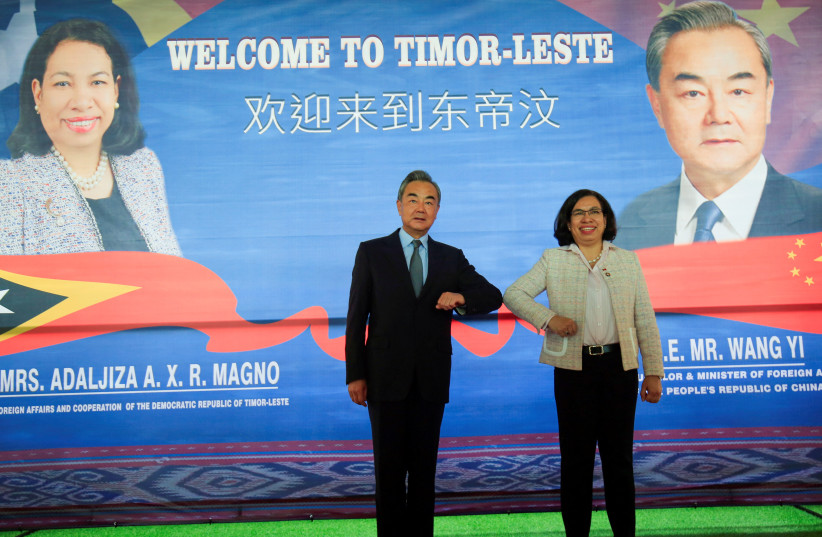Two reports recently paint a picture of growing Western tensions with China in the Pacific.
The first is a story about China doing outreach to Pacific Island nations. The second is the story of Canadian military aircraft operating in Asia repeatedly "buzzed" by Chinese jets, according to a report at the BBC.
“Canada says that its aircrews have had to alter their path to avoid collisions while operating in international airspace near North Korea,” the BBC said about the latter reports. “It has called the Chinese behavior unprofessional and potentially risky.”
Then there is the story of China’s foreign minister meeting with Pacific island counterparts. The Guardian says that “China is expected to encourage Pacific countries to sign up to a sweeping regional economic and security deal.”
The importance of this trip by China's Foreign Minister Wang Yi, who was scheduled to visit eight countries in 10 days, is clear. Wang arrived in Fiji’s capital of Suva and then went on to make other visits. On the Chinese list for growing ties and influence are the Solomon Islands, Kiribati, Samoa and Fiji.
If Beijing makes more inroads here, it can potentially reach into the center of the Pacific near key Five Eyes countries such as Australia and New Zealand, and China can also operate more freely between Western allies like Japan and Australia.

US Coast Guard's 'Blue Pacific' operation
American media says that Coast Guard patrols in the area are one way the US is keeping its influence among the island nations and showing that it won’t walk away in the face of China. CNN's report says that the Coast Guard cutter Myrtle Hazard is taking part in an operation called Blue Pacific.
"This is an "overarching multi-mission...endeavor promoting security, safety, sovereignty, and economic prosperity in Oceania while strengthening relationships."
CNN report on the US Coast Guards Blue Pacific operation
According to the report, “the Solomon Islands is just one of several Pacific island nations the US aids under Operation Blue Pacific, including, among others, Kiribati, Samoa, Fiji, Tonga and Papua New Guinea - all stops on the Chinese foreign minister's tour.”
Why this matters is that there is an increasing arms race at sea as the US Navy seeks to confront China and also reduce the use of ships that are not relevant, such as Littoral Combat ships that the Navy spent huge sums to make and now doesn’t want. But beyond the troubled ships, which are a sunk cost, is the need for new weapon systems and more ships, as well as unmanned vessels.
New deals with Australia and other countries are important. On the political stage, this matters because of recent American statements and congressional trips to Taiwan, as well as China’s pushback.
A reminder of World War I
The overall message of China’s interest in the small Pacific islands is not about influencing the small population there, but likely putting this vast swath of Oceania into play as an area of big-country politics. This is a reminder of the days before World War I, when large countries jostled for influence globally, sometimes almost coming to blows at places like Fashoda in what is now South Sudan.
In those days, Germany also had sought to extend its control to islands in the Pacific. Berlin had outposts at what was then the Bismarck Archipelago, Bougainville, New Guinea, Mariana, Caroline and Marshall Islands of Micronesia, Nauru, the western part of Samoa and the northern Solomon Islands.
Although it is not a direct parallel to the current operations of China and the West in the Pacific – because China is an Asian naval power – it should be recalled what happened in the Pacific during World War I because it is an interesting sliver of history that played out in some of the same areas.
At the time, the Germans had an East Asia Squadron of ships under a German officer named Maximilian Von Spee. His role was to take his ships to areas where the Germans were seeking influence, such as Singapore and what was then Batavia in the Dutch East Indies.
When the war broke out in 1914, he took his ships Scharnhorst and Gneisenau and the light cruisers Emden, Nürnberg, and Leipzig and sailed across the Pacific. He made use of German colonies at Tsingtao and a post at Pagan Island in the Marianas. Members of the German squadron left Pagan for Enewetak Atoll in the Marshal Islands, proceeding across the Pacific where they defeated a British squadron before eventually being defeated in the Atlantic.
China is now apparently vying to gain similar influence in the American-backed Pacific region.
